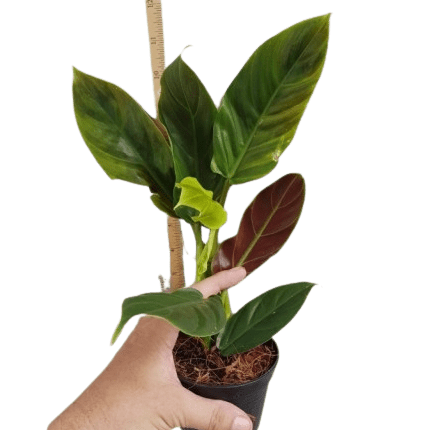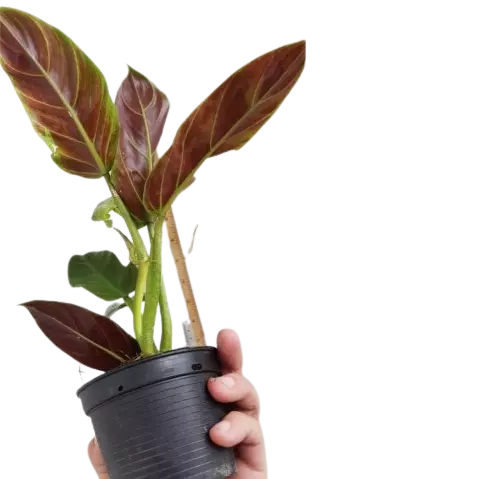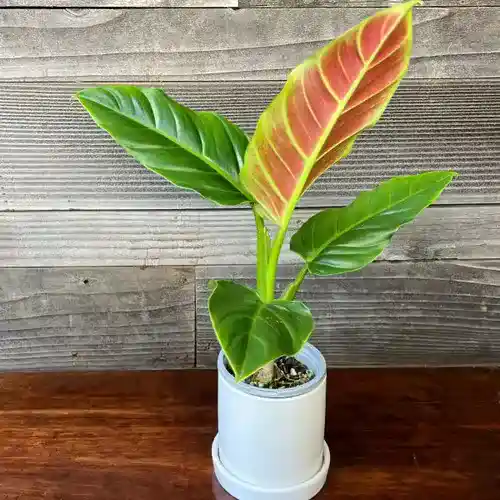- You cannot add that amount to the cart — we have 5 in stock and you already have 5 in your cart. View cart
Philodendron Subhastatum
₹550.00 Original price was: ₹550.00.₹99.00Current price is: ₹99.00.
17 in stock
Size: Single Plant | 2.5″ Pot Included | Secure Packing
The Philodendron Subhastatum is a beautiful, easy-to-care-for houseplant, known for its green leaves with striking red undersides.

Here’s a comprehensive guide to Philodendron Subhastatum’s care:
1. Light:
- Bright, indirect light is ideal. This promotes faster growth and more vibrant leaf color, especially for any variegation.
- It can tolerate medium light conditions, but growth may be slower.
- Avoid direct sunlight, as it can scorch the leaves.
- Good locations include east or north-facing windows, or a spot near a south or west-facing window with a sheer curtain to filter the light.
2. Watering:
- Allow the top 1-2 inches (2.5-5 cm) of soil to dry out between waterings. You can check this by sticking your finger into the soil.
- It prefers consistently moist soil but not wet or soggy. Overwatering can lead to root rot, which is a common issue for philodendrons.
- Reduce watering frequency during winter when the plant’s growth slows.
- Ensure the pot has drainage holes to prevent water from sitting in the bottom.
- If your plant is drooping, it could be a sign of either over or underwatering, so always check the soil moisture.
3. Humidity:
- Philodendron Subhastatum appreciates average to high humidity, as it’s native to tropical forests.
- Average household humidity is usually sufficient, but occasional misting can help leaves grow larger.
- Placing it near a humidifier or on a pebble tray with water can also boost humidity.
4. Soil:
- Use a loose, well-draining potting mix that is rich in organic matter.
- A good mix might include:
- Potting soil (40%)
- Coco peat/peat moss (25-30%)
- Organic manure/vermicompost (25%)
- Perlite/pumice (5-20%)
- Charcoal chips (5%)
- A balanced acidic soil (pH 6-6.5) is beneficial.
- It’s important that the soil drains well to prevent root rot.
5. Temperature:
- Philodendron Subhastatum thrives in warm temperatures, ideally between 18°C to 25°C (64-77°F).
- Avoid sudden temperature fluctuations.

6. Fertilizer:
- Fertilize once or twice a month during the spring and summer (growing season).
- Use a balanced liquid houseplant fertilizer (e.g., 20-20-20 NPK ratio).
- You can also supplement with calcium and magnesium, which are important for healthy leaf development.
- Reduce or stop fertilizing during the fall and winter when growth slows.
- Wait at least one month before fertilizing a newly transplanted or young philodendron.
7. Pruning:
- Pruning isn’t strictly necessary but can be done to maintain the plant’s shape, control its size, or remove leggy growth.
- The best time for pruning is early spring or fall.
- Always remove any yellow or damaged leaves.
8. Repotting:
- Repot your Philodendron Subhastatum every 1-3 years, or when it becomes root-bound and outgrows its current pot.
- The best time to repot is in the spring.
- Choose a pot that is at least 2 inches larger than the current one.
9. Propagation:
- Philodendron Subhastatum is relatively easy to propagate from stem cuttings.
- In water:
- Take a healthy stem cutting about 6 inches long with a few leaves, cutting just below a leaf node.
- Remove the leaves from the bottom half of the cutting.
- Place the cutting in a glass of water, ensuring the nodes are submerged.
- Place in a warm spot with bright, indirect light. Change the water if it becomes cloudy.
- Roots should appear within a few weeks. Once they are at least an inch long, you can plant the cutting in soil.
- In soil:
- Take a similar stem cutting as for water propagation.
- Remove leaves from the lower half.
- Plant the cutting in a well-draining potting mix, ensuring the nodes are below the soil surface.
- Keep the soil evenly moist and provide bright, indirect light.
- Gently tug on the cutting after a few weeks; resistance indicates root development. New leaf growth is also a sign of successful rooting.
10. Pests and Diseases:
- Common Pests: Watch out for aphids, mealybugs, spider mites, and scale insects. Inspect your plant regularly, especially the undersides of leaves. Treat with insecticidal soap, neem oil, or by manually removing pests.
- Common Diseases:
- Root Rot: Primarily caused by overwatering. Symptoms include yellowing leaves, mushy roots, and wilting. If detected, remove the plant, trim affected roots, and repot in fresh, well-draining soil.
- Leaf Spot Diseases: Can be bacterial or fungal, appearing as brown or black spots on leaves. Ensure good air circulation and avoid overwatering.
- Nutrient Deficiencies: Yellowing leaves can indicate a lack of magnesium or iron.
- Good air circulation and proper watering practices are key to preventing most diseases.

By following these care guidelines, your Philodendron Subhastatum should thrive and bring a touch of tropical beauty to your home.
Only logged in customers who have purchased this product may leave a review.
Related products
-
Scindapsus Pictus Exotica
₹380.00Original price was: ₹380.00.₹99.00Current price is: ₹99.00.Add to cartSelling size: Single Plant | 2.5″ Pot Included The Scindapsus Pictus Exotica, also known as the silver pothos, is a houseplant with large, dark green leaves that have silver spots and mottling. Here’s a guide to caring for your Scindapsus pictus Exotica plant: Light: Prefers bright, indirect light. An east or west-facing window that’s about …
-
Pellionia repens var. pulchra
₹325.00Original price was: ₹325.00.₹99.00Current price is: ₹99.00.Add to cartSelling size: Well rooted plant in a jiffy bag | Secure Packing The Pellionia repens var. pulchra, often called the Trailing Watermelon Begonia, is a beautiful and easy-to-care-for trailing plant. Its common name comes from the striking, patterned leaves that resemble the rind of a watermelon. Despite the name, it is not a true begonia …
-
Golden Pothos
₹355.00Original price was: ₹355.00.₹99.00Current price is: ₹99.00.Add to cartSelling size : Well rooted plant | 2.5″ pot included The Golden Pothos (Epipremnum aureum), also known as Devil’s Ivy, is one of the most popular and easiest houseplants to care for, making it an excellent choice for beginners. It’s a vining plant with heart-shaped leaves that are a vibrant green, often with splashes or …
-
Philodendron Xanadu
₹450.00Original price was: ₹450.00.₹175.00Current price is: ₹175.00.Rated 5.00 out of 5Add to cartSelling size:Well rooted plant | 2.5″ Pot Included Winter Orchid Requirements: Growing Orchids During Winter It will form a dense clump of beautifully lobed leaves and will tend to grow wider than taller. The Xanadu philodendron houseplant can grow to 2 to 4 feet tall (0.6 to 1.2 m.) and up to 4-6 feet (1.2 …
-
Dischidia Oiantha plant
₹695.00Original price was: ₹695.00.₹375.00Current price is: ₹375.00.Add to cartPlant Size: Single plant | 2.5″ Pot Included | Free Shipping | Secure Packing The Dischidia oiantha, often referred to as a “Hoya cousin,” is a charming, easy-to-care-for epiphyte with trailing vines and small, oval, succulent-like leaves. It’s a great choice for hanging baskets or for adding a touch of whimsy to a shelf. Here …
-
Pilea Repens, Black Panamiga
₹280.00Original price was: ₹280.00.₹129.00Current price is: ₹129.00.Rated 5.00 out of 5Add to cartSize: Single Plant | Jiffy Bag Caring for a Pilea Ripens (also known as Black Panamiga) involves understanding its specific needs to ensure it thrives. Here’s a breakdown of Pilea Repens, Black Panamiga key care aspects: Key Care Points: Light: Pilea repens prefers bright, indirect sunlight. Direct sunlight can scorch its leaves. Rotating the plant …
-
Philodendron Mexicanum
₹1,090.00Original price was: ₹1,090.00.₹749.00Current price is: ₹749.00.Add to cartSelling size: Single Plant | Pot included The Philodendron mexicanum is a beautiful vining plant known for its long, arrow-shaped leaves with a striking deep maroon or reddish underside. As its name suggests, it is native to the tropical forests of Mexico. It’s a relatively easy-to-care-for plant, especially for those familiar with other vining philodendrons. …
-
Tillandsia Stricta (Air plant)
₹400.00Original price was: ₹400.00.₹299.00Current price is: ₹299.00.Add to cartSelling size: Single plant How to Grow Tillandsia Stricta A hardy and popular air plant IN THIS ARTICLE Care Propagating Tillandsia stricta is a common species in the air plant family, but this doesn’t make them any less special. Their versatility makes them a popular choice, and their vibrant blooms make them a beautiful addition to …
- Today's Offer322322 products
- Shop All12291229 products
- Featured Collections12121212 products
- MOSSES11 product
- AIR PLANTS77 products
- BEGINNER FRIENDLY582582 products
- BONSAI3737 products
- CREEPERS280280 products
- FLOWERING PLANTS290290 products
- FOLIAGE PLANTS858858 products
- FRUIT PLANTS1515 products
- GIFTING PLANTS189189 products
- HANGING PLANTS373373 products
- MEDICINAL PLANTS66 products
- PET FRIENDLY PLANTS371371 products
- RARE PLANTS622622 products
- STRINGS SUCCULENTS3737 products
- SUCCULENTS113113 products
- TERRARIUM PLANTS479479 products
- TREE7171 products
- VARIEGATED PLANTS220220 products
- VEGITABLES55 products
- WATER PLANTS3030 products
- Plants By Size12031203 products
- Plants By Price836836 products
- Under ₹99148148 products
- Under ₹199203203 products
- Under ₹299418418 products
- Under ₹399494494 products
- Under ₹599627627 products
- Under ₹999813813 products
- Plants By Variety11311131 products
- Aralia55 products
- Cryptanthus44 products
- Medinilla11 product
- Adenium2222 products
- Aglaonema3232 products
- Alocasia & Colocasia5454 products
- Altheranthera11 product
- Anthurium9292 products
- Baby Sunrose22 products
- Bamboo33 products
- Banana Variegated55 products
- Begonia33 products
- Bougainvillea1414 products
- Bromeliads22 products
- Cactus1616 products
- Caladium2121 products
- Calatheas & Marantas4545 products
- Carnivorous1212 products
- Costus55 products
- Croten44 products
- Dischidia88 products
- Dracenia99 products
- Drimiopsis33 products
- English Ivy44 products
- Episia33 products
- Ferns7676 products
- Euphorbia1111 products
- Fittonia66 products
- Grass33 products
- Haworthia22 products
- Heliconias44 products
- Homalomena1616 products
- Hoya1313 products
- Ixora22 products
- Jade22 products
- Labisia1414 products
- Lipstick plants1010 products
- Monstera5353 products
- Orchids4444 products
- Coelogyne Rochussenii Fragrance Orchid11 product
- Dendrobium Orchid1010 products
- Mokara Orchids1717 products
- Mokara Orchid (Matured Plant)1414 products
- Mokara Orchids (Special Varietys)33 products
- Phalaenopsis, Moth orchid1616 products
- Oxalis Triangularis/ Butterfly Plant55 products
- Palm88 products
- Peace Lily77 products
- Pedilanthus88 products
- Pelliona Repens33 products
- Pepperomia1515 products
- Petrea44 products
- Philodendron153153 products
- Pilea66 products
- Pine22 products
- Piper2121 products
- Pothos & Scindapsus3232 products
- Rubber plants88 products
- Schismatoglottis77 products
- Snake plants77 products
- Syngonium4444 products
- Spider plants1313 products
- Tapioca33 products
- Thunbergia77 products
- Torenia77 products
- Tradescantia Varietys1111 products
- Zz Plants55 products
- Other plants163163 products
- Plants By Location549549 products
- Balcony plants470470 products
- Bedroom plants118118 products
- Kitchen plants9898 products
- Livingroom plants137137 products
- Office plants124124 products
- Outdoor plants303303 products
- Restroom plants8282 products
- Best Sellers6868 products
- Combo Offers1616 products
- Garden Accessories3737 products
- Bulbs And Tubers88 products
- Fertilizers11 product
- Insecticide11 product
- Planters55 products
- Pot Hanger88 products
- Potting Mix33 products
- Seeds1313 products

































 If you need any assistance, I'm always here. Have you found what you were looking for?
If you need any assistance, I'm always here. Have you found what you were looking for?
Reviews
There are no reviews yet.